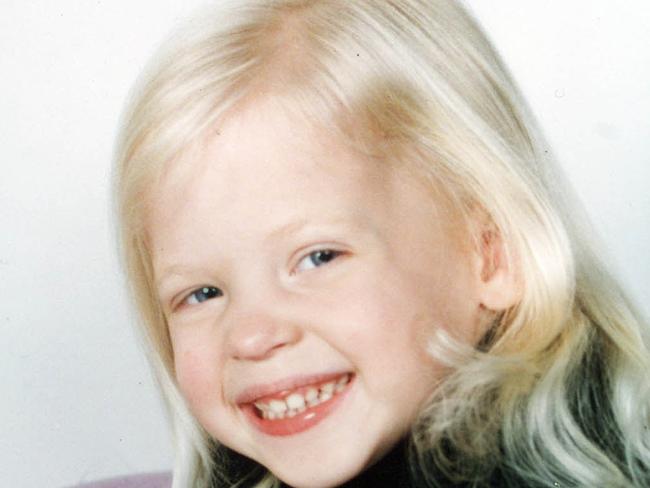No real answer to why Courtney Morley-Clarke was lost to a monster in the night
Why would a 13-year-old boy get up in the night, carry a sleeping girl out of her house and stab her in the driveway? The answer will never be known.

It was a hot January night in 2001 in Point Clare, a peaceful middle-class suburb on the shores of Brisbane Water near Gosford, where the Morley-Clarke family lived with three-year-old daughter Courtney and her two older brothers.
Her mother had put the little blonde girl to bed at 8.30pm and checked her again about 1am but the next morning her father noticed the screen door, locked at night, was open. When he went to wake Courtney she wasn’t in the bunk she shared with her brother and, as he ran outside to investigate, he found her nightie near the gate.
It was, as Supreme Court judge James Wood would later note, a parent’s worst nightmare.
The police were called and as they were making their search a neighbour, the adoptive father of a 13-year-old boy, had disturbing news: his son, that problematic boy they’d fostered then adopted as a four-year-old, had snuck out of the house in the early hours. The dad had driven around looking for him without luck and when the boy returned about 2.45am, wearing only a pair of shorts, he claimed he’d been out for a walk.

Confronted by police, the boy, known by the pseudonym SLD, said he had seen Courtney during the night; he then proceeded to send the search party on a wild-goose chase, toying with searchers, misleading and misdirecting, seemingly enjoying the growing panic overtaking the neighbourhood, before finally admitting: “I stabbed her in the heart.” He always did like to shock people.
The little girl’s naked body was soon found hidden in tall grass with a stab wound through the heart. It was, Justice Wood said, utterly callous. Senseless and savage.
But why, police asked. Why would he get up in the night, walk down the street to neighbours who were friendly with his family, cut the mesh on the screen door, carry the sleeping girl out of the house and stab her in the driveway? Why?
In response came a series of inconsistent statements: he’d wanted to steal computer games, or get back at one of Courtney’s older brothers for picking on him after Scouts, or take revenge on her parents for repeatedly telling him to get off the grass, or that he was angry with his dad, or that he had “anger from a long period of time” that he couldn’t get out.
The answer will never be known – from almost the time he could talk, court documents reveal, he had a tendency to extreme exaggeration, fabrication and fantasy, making it difficult to know when he was being truthful.

“Whether or not the offence was premeditated or impulsive cannot be resolved, in view of the inconsistent answers SLD has given, the utterly inexplicable and cruel way in which he behaved this night, and his history of exaggeration, fabrication and repetitive anti-social conduct,” Wood said.
The next question was around a possible sexual motive for the crime. SLD denied sexually assaulting Courtney but acknowledged he’d removed her nappy in her bedroom, later telling police he had removed the young girl’s clothes in order to “find a good place to stab her”.
“No evidence was found of any sexual assault, although … concern must be entertained as to whether there was some sexual connotation involved, even if it fell short of a physical interference with her,’’ Wood said.
Two psychiatrists who assessed him at the time said SLD did not seem to be suffering any form of mental illness, though one noted the boy lacked any emotion when describing the killing.
“He added that his history … raised a serious question as to whether there was a sexual motivation behind the murder, and whether he had a predisposition towards violent sexual offences,’’ Wood said.
This history included stealing female underwear from neighbours and urinating on the bed of one of the victims, and exposing his genitals. The week before the murder he was charged with abducting a young girl and indecently assaulting her.
He was a disturbed child who had become an overwhelming problem for his parents, the couple who adopted him as a four-year-old, providing a supportive home after an early life marked by extreme neglect that saw him placed in foster care before the age of two.
His background, Wood noted, was almost as bleak and disturbing as his crime. The court heard the boy’s birth mother had an extensive history of drug use and was abusive to her three surviving children (two other children were stillborn and one died with SIDS). Psychiatric reports suggested she also had a severe personality disorder and had herself been born into a highly dysfunctional family.

Adding to his troubles, SLD had been diagnosed with a chromosomal syndrome that caused a slightly unusual appearance and cognitive effects that could lead to anti-social behaviour. Intelligence testing put him in the borderline disabled range. He presented, said one psychologist, “as a peculiar-looking child who did peculiar things and who related to people in a peculiar way”.
By the time he reached the age of 13, one psychiatrist who assessed him held little hope he would become a reasonably socialised adult.
Presented with all this evidence, the original sentencing judge, Wood, went searching for precedents on what to do with SLD. If he were an adult, he would likely be jailed for the term of his natural life but as a child the court was guided by different sentencing principles. “Very few people of his age have been convicted of such an offence and, fortunately, few attempt it.’’
Wood found parallels with England’s James Bulger, the two-year-old abducted, tortured and murdered by 10-year-old boys Robert Thompson and Jon Venables in 1993.
In that case the boys were sentenced to indefinite detention at Her Majesty’s pleasure on the basis that their propensity to reoffend, and their danger to society, could be properly reassessed when they reached adulthood (they were released at age 18).
This option was not available to Wood, who recommended the law be changed in Australia to allow children convicted of murder to be detained at Her Majesty’s pleasure and resentenced at a later date when a better assessment could be made of their psychological condition and future dangerousness.
Experts were unable to make a definitive diagnosis of SLD’s mental state as a 13-year-old. “I think the most likely diagnosis is that SLD has a severely troubled personality, the full extent and precise nature of his difficulties will become more apparent as he grows older,” one psychiatrist told the court.
By his early 30s he had been diagnosed with severe personality disorder with anti-social and psychopathic features.
“His presentation included aspects of fabrication, guardedness, manipulation and intimidation when challenged,’’ judge Stephen Campbell said in a more recent judgment, quoting a psychiatric report that said: “SLD exhibited grandiose fantasies, a lack of empathy for others, prominent features of arrogance and entitlement, and emotional detachment from others.’’
Campbell said a significant body of evidence presented in this case indicated personality disorders of this type are not amenable to psychological treatment, although some gains could be made.
Forensic psychologist Patrick Sheehan told the court that SLD’s anti-social personality characteristics were at the high end of severity.
And, most alarming for those charged with managing his behaviour outside prison, he added that at the age of 36 SLD “is still some years away from entering a phase of life where his anti-social features might be expected to lessen”.




